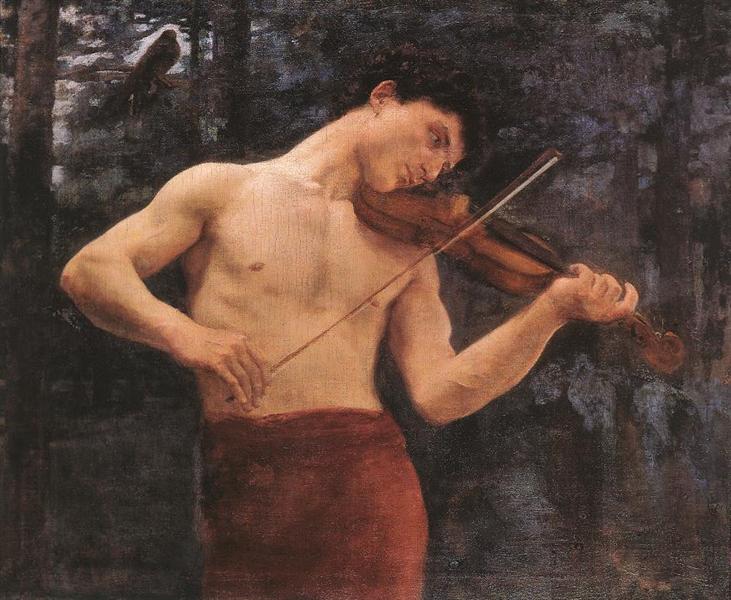Description
"Orpheus" (1894) by Károly Ferenczy is a masterpiece that encapsulates the essence of European symbolism of the end of the nineteenth century, a period marked by the exploration of ancient myths and introspection on the human condition. Ferenczy, one of the pioneers of Hungarian modern art and a central figure of the Nagybánya secession movement, proposes with this piece a lyrical rereading of the myth of Orpheus, the poet and musician tried that moved gods, men and beasts with his music.
In the center of the composition, Orpheus appears reclining, not in a heroic gesture, but in a contemplative possession, merged almost with the nature that surrounds it. His face is serene and reflective, as if listening to the melodies of his lyre resonating in his mind. This intimate approach to a mythological hero underlines Ferenczy's interest not only to represent epic stories, but to delve into the psychology and emotion of the individual.
The use of color is extraordinary and speaks of the artist's technical domain. The predominant palette uses earth and ocher tones that are intertwined with soft and bluish green, creating an ethereal atmosphere that highlights that suggestive moment between reality and sleep. Diffuse contours and loose brushstrokes suggest an enveloping and dreamlike environment, consistent with the symbolist tradition that sought to evoke more to describe.
The composition shows Orpheus wrapped in a natural environment that overflows with vegetation. Green leaves and branches seem to move with the music breeze that still resonates in the air, and the subtle mixture of colors evokes a twilight, an interlude between day and night. Ferenczy achieves with this an intimate relationship between the character and nature, achieving an almost spiritual communion between them.
A remarkable aspect is the way Ferenczy treats light. This seems to come from an internal source, from the Figure of Orpheus, permeating the scene with a faint brightness that highlights the textures of the fabric and skin. There is no evident drama in the use of chiaroscuro, but a hint of light that brings stillness and contemplation to the scene.
Károly Ferenczy had rigorous and varied training that included studies in Vienna, Munich, and Paris. Influenced by masters Classics and contemporaries, his style eventually leaned towards a realism -dyed impressionism that would be his distinctive seal. Orpheus is part of his symbolist period, in which the artist not only explored the technical abilities of painting, but also the evocative potential of his images.
Compared to his other works, such as "Nude" (1903) and "Young Woman" (1906), "Orpheus" stands out for her mythological burden and introspective atmosphere. While most of his work focuses on peasant scenes and portraits of his relatives, this painting It offers a look at the inner universe of a legend character, working on the delicate balance between the human and the divine.
"Orpheus" by Karoly Ferenczy is a piece that invites silent reflection. With its expert use of color, composition and light, Ferenczy transcends the mere representation to reach a deeper interpretation of the myth, causing the painting to resonate even today as a distant echo of the eternal melancholy and beauty of art.
KUADROS ©, a famous paint on your wall.
Hand-made oil painting reproductions, with the quality of professional artists and the distinctive seal of KUADROS ©.
Art reproduction service with satisfaction guarantee. If you are not completely satisfied with the replica of your painting, we refund your money 100%.

